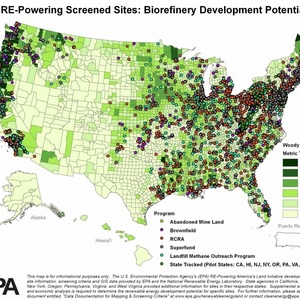EPA's expanded RE-Powering tool shows vast biomass potential




U.S. EPA
August 7, 2013
BY Erin Krueger
The U.S. EPA has updated its RE-Powering Mapping and Screening Tool, which provides preliminary screening results for renewable energy potential at contaminated land, landfill and mine sites. The screening tool is part of the RE-Powering America’s Land Initiative, which began in 2008 and encourages development of renewable energy on land that is potentially contaminated. The tool now profiles 66,000 locations, up from 34,000.
The tool pulls data from EPA databases of potentially and formerly contaminated lands. The program also partners with several stage agencies. According to the EPA, the RE-Powering initiative has worked in collaboration with the U.S. DOE’s National Renewable Energy Laboratory to develop screening criteria for biomass, solar, wind and geothermal potential on identified sites.
“We see responsible renewable energy development on contaminated lands and landfills as a win-win-win for the nation, local communities, and the environment,” said Mathy Stanislaus, assistant administrator for the Office of Solid Waste and Emergency Response. “In President Obama’s Climate Action Plan, the administration set a goal to double renewable electricity generation by 2020. By identifying the renewable energy potential of contaminated sites across the country, these screening results are a good step toward meeting national renewable energy goals in order to address climate change, while also cleaning up and revitalizing contaminated lands in our communities.”
Advertisement
Advertisement
To date, more than 70 renewable energy projects have been installed on contaminated lands or landfills through the initiative, representing more than 200 MW of combined capacity. According to EPA documentation, only one of these projects is currently employing biomass. However, that project features 20 MW of installed capacity. Solar accounts for the majority of RE-Power projects to date, with 60 projects and a combined capacity of 135.9 MW. Wind accounts for 9 projects with a combined 61 MW of capacity. Hydro and geothermal each also account for a single project.
A Re-Powering Mapper fact sheet on biomass technologies specifies that the EPA has identified 9,591 sites as potential locations for a biorefinery facility. These locates feature cumulative biomass sources of at least 700,000 metric tons per year within 50 miles, are at least 50 acres in size and are close to roads and rail.
The fact sheet also notes that 9,966 potential sites have been identified for biopower development. These sites have cumulative biomass resources of at least 280,000 metric tons per year within 50 miles, are at least 50 acres in size, are less than 10 miles from transmission lines, and are close to graded roads and rail.
Advertisement
Advertisement
Finally, 1,947 sites are identified as potential locations for landfill gas energy projects. This includes sites that currently have landfill gas energy facilities, construction projects, or that have been identified by EPA’s Landfill Methane Outreach Program as a candidate or potential site.
According to the fact sheet, biomass potential at EPA’s tracked sites is more than 190,000 MW on a technical level.
Related Stories
The U.S. Department of Energy Bioenergy Technologies Office (BETO) announced up to $23 million in funding to support research and development (R&D) of domestic chemicals and fuels from biomass and waste resources.
The U.S. DOE has announced its intent to issue funding to support high-impact research and development (R&D) projects in two priority areas: sustainable propane and renewable chemicals and algal system cultivation and preprocessing.
Sens. Sherrod Brown, D-Ohio, and Pete Ricketts, R-Neb., in August introduced the Renewable Chemicals Act, a bill that aims to create a tax credit to support the production of biobased chemicals.
The Chemical Catalysis for Bioenergy Consortium, a consortium of the U.S. DOE’s Bioenergy Technologies Office, has launched an effort that aims to gather community input on the development of new biomass processing facilities.
USDA on March 8 celebrated the second annual National Biobased Products Day, a celebration to raise public awareness of biobased products, their benefits and their contributions to the U.S. economy and rural communities.
Upcoming Events










